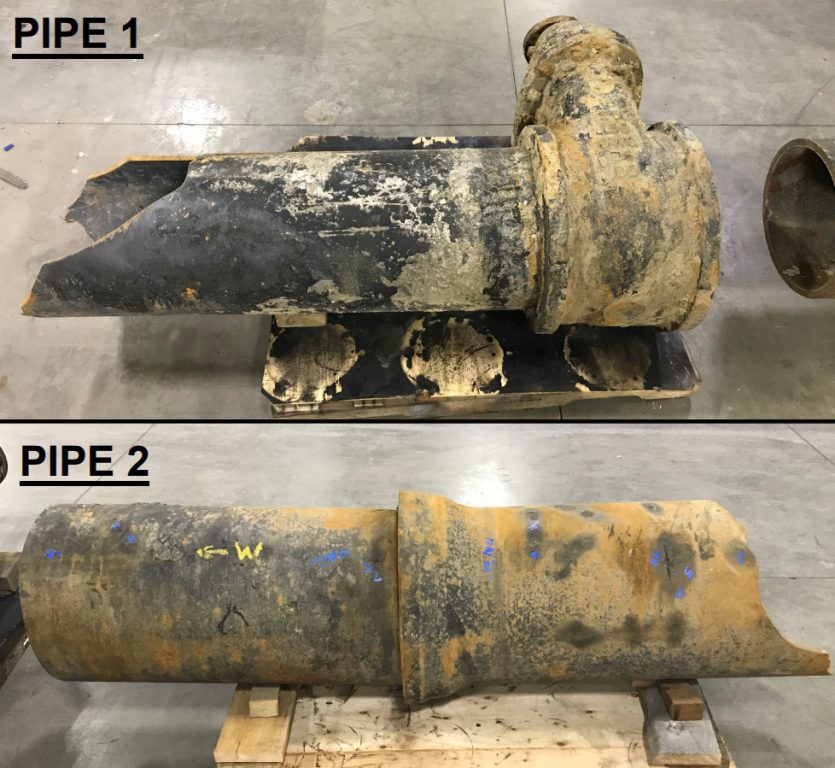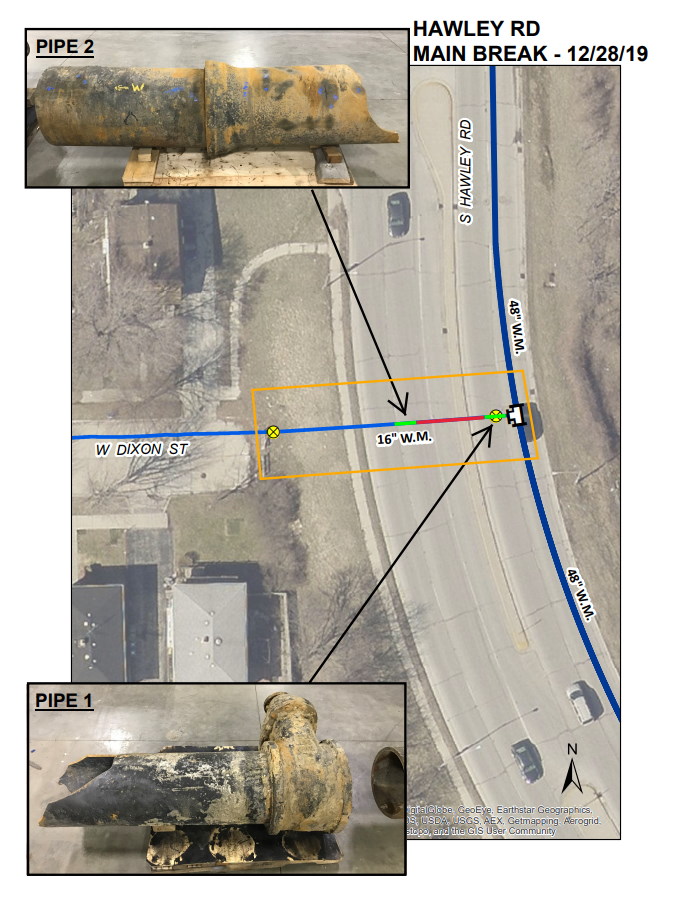Pipe Destroyed in Water Main Break
"Very, very rare" break destroys 29 feet of water main, raises questions, devastates residents in area.
At 8:57 a.m. on Saturday, December 28th, an alert went off at the city’s Linnwood Water Treatment plant on the shore of Lake Michigan. A sensor on the city’s west side, one of many in the city’s 1,960 miles of water mains, was reporting an “extreme pressure drop.”
It wasn’t a false alarm.
By 9:03 a.m. the Milwaukee Police Department had called the Milwaukee Water Works (MWW) to report a water leak near S. Hawley Rd. just south of Interstate 94.
MWW officials initially thought it was a break in a 48-inch concrete water main that runs under S. Hawley Rd. The decision was made to shut off water to a segment of the pipe.
But closing off a major water main in a hurry isn’t an easy task. Two butterfly valves, each requiring 900 manual turns by a two-person crew, would need to be closed in tandem to prevent a “water hammer,” a hydraulic shock from abrupt momentum change, which could cause further breaks.
In the meantime, nearby streets began to more closely resemble rivers.
Approximately 40 individuals are now expected to file claims against the city. Some have cars that were flooded, others had up to three feet of water in their basements. In almost every case, homeowners insurance would not cover the damage because it was caused by a flood.
What happened? That’s the million-dollar question the city is trying to answer.
What is known is that 29 feet of a 60-year-old, 16-inch cast iron water main servicing W. Dixon St. was effectively destroyed. One end of the remaining pipe shows “significant corrosion.”
MWW Superintendent Karen Dettmer briefed the Common Council’s Public Works Committee Wednesday morning on the city-owned utility’s response.
“This is a very, very rare circumstance,” said Dettmer, who has lead the utility for just under a year. She told the committee, which includes area Alderman Michael Murphy, that employees with over three decades of experience have never seen anything like it.
“The vast majority of our water main breaks are on six- and eight-inch mains,” said Dettmer. “The most common break is due to corrosion. On this particular pipe, we had many areas of corrosion.”
What Happens Next?
A series of processes are now underway to address everything from restoring water service and rebuilding S. Hawley Rd. to handling damage claims and researching what happened.
Pumps were added to clear the site of the break, with quite a few residents also needing pumps to clear their basements.
The recovered segments of the pipe have been sent to a materials testing lab for review. The city is also in contact with the manufacturer regarding potential manufacturing defects in the pipe.
Water service, delivered via the other end of the 16-inch main, was restored by 10:30 p.m. the evening of the break after a new valve was installed.
Mid City Corporation installed a new, 85-foot-long, 16-inch main segment and welded it to the 48-inch main. Three epoxy coats are now being applied to the main to seal it. The 48-inch main remains shut off. “They have been a great partner,” said Dettmer of Mid City’s assistance. S. Hawley Rd. is scheduled to fully reopen to traffic on Monday, January 13th.
Dettmer also praised MWW claims processor Michelle Thompson-Gray for her hard work including visiting homes and volunteering to work on New Year’s Eve when city offices were closed. Dettmer said Thompson-Gray’s work would help speed up the city’s ability to respond to claims.
“What about liability?” asked Alderman Robert Bauman.
“Our investigation is ongoing and we will be tireless in finding out what exactly happened here for many reasons,” said Dettmer as deputy city attorney Jan Smokowicz approached the table.
“That’s important, we always like to know what caused this type of mishap,” said Bauman. “That’s all nice. The homeowner is interested in who’s going to reimburse them for their damages, if anybody.”
“At this point we, like you, are just obtaining information on this,” said Smokowicz. The attorney said other resources are available in the meantime.
“Those resources are not quick,” said Bauman. “Someone applies for a STRONG home loan, they might be likely to get their money in six months.”
“This is a very blue-collar, hard-working neighborhood,” said Murphy. “This is a huge financial burden for a lot of these residents.” Murphy said he expected half of the claims to be related to automobiles, because an apartment building parking lot at 427 S. Hawley Rd. was flooded.
“I’m going to certainly advocate very strongly on behalf of these residents,” said Murphy. He asked that the City Attorney’s office find an administrative resolution.
To sue the city for damages, individuals must first submit a claim against the city. The Common Council, at the advice of the City Attorney, can reject those claims to allow a lawsuit in Milwaukee County Circuit Court or settle the claims.
Legislation Link - Urban Milwaukee members see direct links to legislation mentioned in this article. Join today
If you think stories like this are important, become a member of Urban Milwaukee and help support real, independent journalism. Plus you get some cool added benefits.
Political Contributions Tracker
Displaying political contributions between people mentioned in this story. Learn more.
City Hall
-
Council Blocked In Fight To Oversee Top City Officials
 Dec 16th, 2025 by Jeramey Jannene
Dec 16th, 2025 by Jeramey Jannene
-
Latest Effort to Adopt New Milwaukee Flag Going Nowhere
 Dec 3rd, 2025 by Jeramey Jannene
Dec 3rd, 2025 by Jeramey Jannene
-
After Deadly May Fire, Milwaukee Adds New Safety Requirements
 Dec 2nd, 2025 by Jeramey Jannene
Dec 2nd, 2025 by Jeramey Jannene
























““This is a very blue-collar, hard-working neighborhood,” said Murphy. “This is a huge financial burden for a lot of these residents.”
Strikes me as beyond the point. So, if it were a neighborhood that had mostly salaried or retired residents … ? Or, as in my case, a “ retired on fixed income” owner of a rental property a few blocks away?
Mr. Murphy would be better off to state: “Regardless of anyone’s financial situation, restoration and/or replacement of flooded property and possessions like automobiles, for example, is potentially a huge burden and serious disruption ….” etc.